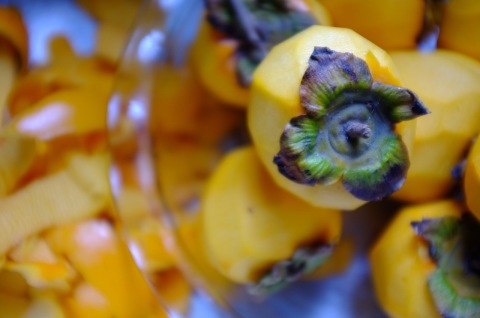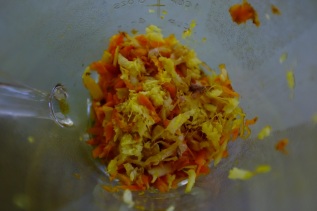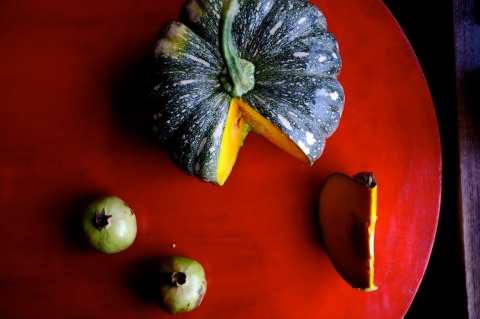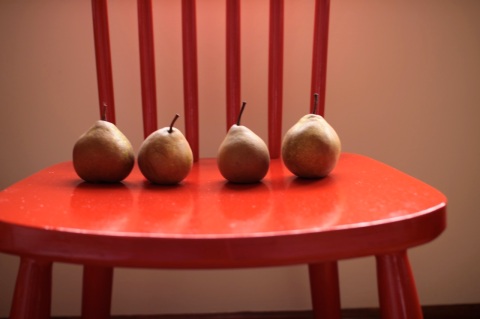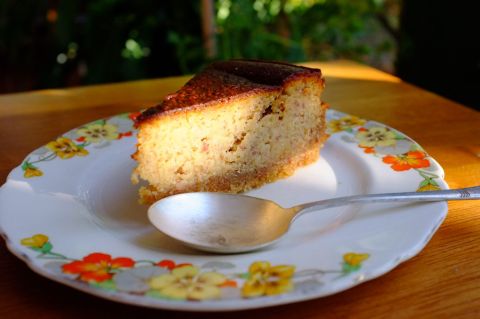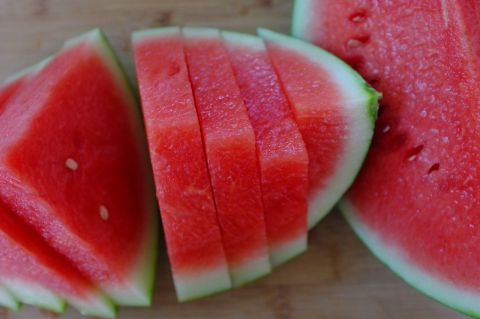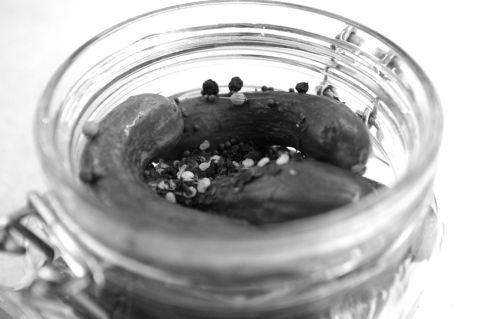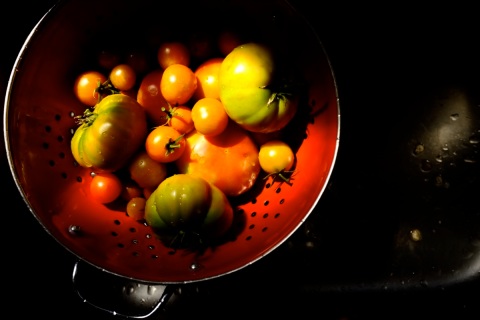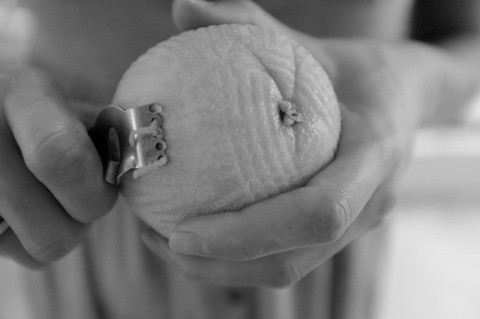a turmeric life
May 25, 2014 § 3 Comments
I have almost been living off this drink the last 6 months. Served ice cold and sipped on the verandah in the evenings, the colour matching the turmeric setting sky. Its gently spicy and refreshing in a heart warming kind of way. AND, its body pleasing too. Turmeric has great anti-inflammatory and antioxidant properties and is wonderful for settling an upset tummy. Interestingly, when served with black pepper the bioavailability of curcumin – its active ingredient – is enhanced 1000 times.
Iced Turmeric Tea
1 tsp powdered turmeric or 2 Tbsp fresh grated turmeric
2 – 3 Tbsp fresh grated ginger
A handful of freshly cut lemongrass (2 Tbsp of dry lemongrass tea would work too)
1 tsp peppercorns
2 Litres boiling water
Place all ingredients in a large bowl or glass jug. Pour over boiling water and allow to seep until cool. You will end up with a rich tonic that you can then store in the fridge. To serve, add around 2 shots of tonic to 1 cup cold water or mineral water and squeeze in some fresh lemon or lime.
a small cause for celebration
November 24, 2013 § 3 Comments
Three years ago to this day I started a blog, inspired by living and working as a cook at Friendly Beaches Lodge and, of all things, an article in a Jetstar inflight magazine about blogging. Before I read the article, I didn’t even know what a blog was (yes, mainly becuase I had been living under a rock in Tasmania). Whilst I don’t remember exactly what the article was about, I do remember that something in me stirred and at 25 000 feet above the Bass Strait en route to Melbourne I decided to start a blog. It would be a food blog, with stories and recipes and a focus on sustainable, local, seasonal, unplugged cooking. But, most importantly it would be a place to keep me creative, to force me into the kitchen and taking photos, a place to try to pull words from my thoughts and scrawl them on a blank screen. And so I wrote, “What better thing to do on a hot spring day than start a food blog…” 3 days later I was unexpectedly on a plane to Sierra Leone and my “food blog” was momentarily hijacked by travel stories.
Since then I have often enjoyed, occasionally hated, been frustrated, exhilarated, both ashamed and very proud of this place. I have tried very hard to be honest with myself and have had to learn to be brave, to throw words out to the world and that strangely intimidating public realm. But here I am with 3 years of stories from my wooden spoon and my favourite blue ceramic pot. I am so grateful to each of you who have read this blog. You who have put up with my terrible spelling and my often flippant nature in the kitchen, thank you so much. It humbles me no end to think that I may sometimes write something that someone wants to read and cook something that someone wants to cook.
A small cause for celebration, here are some of the recipes from the last three years that I love the most.
Quinoa Pancakes
Strawberries and Basil
Chocolate Coated Dried Plums Marinated in White Wine and Thyme
Oma’s Cabbage
Osso Buco
Zucchini and Bacon Soup
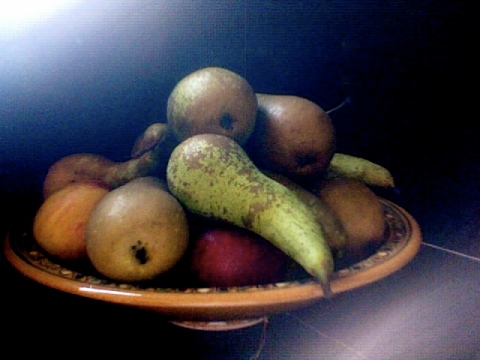
late september
September 28, 2013 § 3 Comments
I had a dismal attempt at trying to grow watermelons this year. The process started with me very excited. I made a little round bed full of compost and manure and planted two little seeds inside. They sprouted and grew… A little… I watered them and they grew some more. They bloomed tiny little flowers and even grew one tiny little watermelon. Then I went away and the little watermelon shrivelled up. Then the rest of the vine shrivelled. And one day they were dead. And that was that.
The sun is relentless here. Unforgiving. I realise my mistake, I shouldn’t have put them in a place that gets all day sun, and I should definitely have mulched them more.
But still, I have been managing to eat some of the very best watermellons I ever had. The local ones are cheep and abundant at this time of year. They are a deep bright pink and so so sweet.

So I have a recipe for you today, a drink, and a very refreshing one at that. It comes out of the beautiful cookbook The New Persian Kitchen. Its a watermelon, mint, and cider vinegar tonic!
Author Notes: “Even if drinking vinegar sounds like a dare — and maybe that’s why you ordered it — it’s anything but. It’s sweet and sour and icy-cold. It vibrates and clangs with fruit and vinegar, and soothes with sweetness and mint. It is the most refreshing drink you will have this summer”. From The New Persian Kitchen
Recipe for Watermelon Mint and Cider Vinegar Tonic
Makes about 5 cups concentrate
3 cups water, plus more to serve
1/4 teaspoon sea salt
1 cup honey
6 cups coarsely chopped watermelon
1 cup tightly packed fresh mint, plus more to serve
1 cup apple cider vinegar (preferably with the mother because that is the best kind for you)
Ice cubes, cucumber, and lime to serve.

- Boil the water and salt in a medium saucepan. Add the honey and allow to dissolve before removing from the heat.
- Combine the watermelon and mint in a large bowl and stir in the hot honey water. Leave to cool to room temperature.
- Once cool, add the vinegar and allow the mixture to steep in the refrigerator for several hours or up to overnight.
- Strain the mixture and eat the watermelon chunks, if desired.
- Store the concentrate in a clean glass jar in the refrigerator for up to 1 week.
- To serve, pour 1/4 cup of the concentrate into a glass over ice and dilute with 3/4 cup water. Garnish with the watermelon, cucumber, and mint.

snake beans
July 15, 2013 § 2 Comments
The Tropical Garden Spectacular was on a few weeks ago. At the botanical gardens under trees with impossibly huge canopies I watched some local food cooking demonstrations. Lined up on straw bales with the green grass at our feet, some glimpse of paradise on the warm breeze, the chef Selvam Kandasamy from Saffrron, taught a small group of us how to make snake beans, sautéed in spices with coconut and curry leaves. And this my dear friends is a dish to be celebrated.
Snake beans are the lanky tropical equivalent of the green bean and you would be forgiven for thinking them somewhat tough and woody with little flavour. This recipe however does them justice. It is full of flavour, crunchy, slightly sweet, bright green and turmeric yellow. The coconut and chili melts on your tongue. The intermittent curry leaves are bright in your mouth. The beans are cooked hot in a wok for just the very right amount of time making them softly crunchy and fluorescent.
I have made this recipe many times since then and each time I have continued to love it. It is similar to the original made by Selvam Kandsamy except I have used coconut oil instead of peanut oil.
Spicy Snake Beans with Coconut and Curry Leaves
Serves: 4 – 5 as a main or 6 – 8 as a side dish.
Note: If you are in distant and cooler parts wanting to use something more locally appropriate I am sure green beans would also make a good substitute.
3 Tbsp pure coconut oil
2 flat tsp brown mustard seeds
2 flat tsp turmeric
1/2 tsp salt
1 red onion finely diced
1 whole fresh red chillis (you can also use 1 tsp dried chilli flakes instead)
1 Tbsp Split yellow lentils (optional)
4 cups chopped snake beans
1/2 cup shredded coconut
A good handful fresh curry leaves
Extra salt to taste

Prepare all your ingredients before hand. Once you start cooking it all happens fast.
In a wok heat the oil on a medium to high flame until hot. Add the mustard seeds, turmeric, onion, and salt. Stir until the onions turn just translucent, then add the chilli and lentils. Continue stirring and add the beans and coconut stirring until the beans are just cooked through but still have a crunch and are bright green. Add the curry leaves and remove from heat.
It is lovely served as a side to fish or on its own with brown rice.
I hope you like it as much as I do.
pickles
June 23, 2013 § Leave a comment
Without meaning to belabour the point, winter is an exciting time in the top end. Really it is like summer down south and the vegies that grow this time of year are proof of that. We have four cucumber plants in pots under the verandah in anticipation that they will provide some edible shade in the coming months. But in the meantime, I have been getting them from the markets, small and sweet, straight from the local growers at Humpty Doo.
And I know I have mentioned this to you before, but I do love pickles. Crunchy, tart, sour, salty. In true wholesome, traditional and healthy fashion, I have provided you with an old recipe for making pickles, one that uses ancient methods of fermentation and preservation. This way you get all those wonderful lactobacillus which I have been told, on countless occasions by my mother, – are very very good for you. And mothers are always right.
If you want a recipe for pickles that tastes like those you buy in the shops you will need to look elsewhere. Inspired by Jenny at Nourished Kitchen, this recipe uses salt rather than vinegar and as a result, the lacto fermentation process. But still, below I have given you two options for making brine. The first is exclusively with salt and the second is with less salt and a small amount of apple cider vinegar. You can decide which version you like the best.
Lacto fermented pickled cucumbers
For pickling, try to use freshly picked cucumbers if possible, but if not, get ones that are organic and as fresh and small as you can find. Say no more than 2 inches long.
Ingredients
Enough pickling cucumbers to fill your jar(s).
4 cloves of fresh organic garlic – per 500ml jar
1 tsp spices (for example, allspice, mustard seeds, bay leaf, black pepper, dried chilli flakes etc) – per 500ml jar
Optional – Use 1 fresh grape-vine leaf with the stem removed or a horseradish leaf per 500ml jar. This will help your pickles to stay crisp when the lactic acid fermentation is complete.
Brine
Option 1: 2 ½ – 3 tablespoons of salt per 4 cups of chlorine free filtered water
Option 2: 1 tablespoon of salt and 2 tablespoons apple cider vinegar for every 3 cups of chlorine free filtered water.
(1 cup of brine usually fills a 500ml jar)
Method
If you were unable to pick your cucumbers fresh, the first thing you will need to do is soak them in very cold icy water to perk them up before they ferment. Next, you’ll want to make sure all stems and flowery ends have been removed as they may give an off-flavor to the pickles. I generally cut a tiny scrape off the ends of each cucumber with a knife to be certain. It is also important that each cucumber is cleaned carefully. These steps will help ensure your pickles remain crunchy.
Place the pickling cucumbers, garlic and spices in sterilised jars in layers and ensure that they are a snug fit but without damaging the cucumbers. Add the horseradish or grape-vine leaf if you have it.
Prepare your brine. Shake or stir to help the salt fully dissolve. Pour the brine over the pickling cucumbers, until all of the ingredients are submerged. It is important that all of the ingredients are covered with the brine, and if necessary add a clean weight into the jar to help push them under the liquid, for example, a small plastic lid. Secure the lid and allow to ferment at room temperature for between 5 and 10 days, depending on your climate. The cooler it is the longer it will take. Once they are ready, store in the fridge to be eaten as you please.
As a side, I know it can be a fear with people, as it was with me, to be uncertain about whether your ferments are off. All I can say is, trust me, you will know. The smell is bad enough that you won’t want to touch them.
pho
May 6, 2013 § Leave a comment
Its been two and a half months since we moved to Darwin. In that time, I have started making a basket out of scrap material collected over my 29 years, made huge amounts of pickled cucumbers, watched far to many murder mysteries, tried to commit myself to balancing on my head at least once a day, finally got a job, and consumed large quantities of pho. AND pho could just so happen to be the very best thing that has happened to me since I arrived. A traditional Vietnamese soup, it’s so easy to make, and so so tasty.
As I have learnt, there are a few things you need to consider when making pho. The first is your stock. I always recommend people make their own stock out of organic meat, rather than buying it from the store. Not just because it tastes so much better but because homemade stock is very very good for you.
For pho, I have made and used stock from chicken, beef and fish. All work well, just adding a slightly different flavour. Just remember that fish stock can be quite strong, so adjust the quantities as needed.
The next thing you need to consider is the herbs you garnish your pho with. My favourite by far is Thai basil, but you can also use coriander, mint and traditional basil or combinations of each.
How to make stock
To make stock, I usually use the leftover bones and carcass from the previous nights roast dinner (about 1 – 2 kg). If I haven’t had a roast in a while, I will sometimes use 4 chicken drumsticks instead. I will place them in a large pot with one or two bay leaves and a good pinch of salt. Some people add vegetable scraps too and you can if you want. This is then covered with water, (about 4 – 6 litres) and brought to the boil before leaving to simmer for 3 – 4 hours, skimming the scum as needed. This can then be frozen into serve size portions (say two cups each) and used when needed. It will keep in the fridge for about 4 days and in the freezer for 3 – 4 months.
Pho (serves 4)
For the broth
4 cups stock
4 cups water
4 star anise
1 – 2 cinnamon quills
1 inch piece of ginger cut in half
1 onion cut into quarters
4 cloves garlic peeled
1/3 cup fish sauce
To serve
375 g flat rice noodles
Roughly 300 g organic beef very thinly sliced
2 limes cut into quarters
A bunch of fresh Thai basil
About 200 g beansprouts
2 fresh chillies cut into strips
Chilli sauce (optional)
Hoisin sauce (optional)
Additional fish sauce
Method
Place, stock, water, star anise, cinnamon, ginger, onion, garlic and fish sauce in a large saucepan and bring to the boil. Cover and allow to simmer for around 30 minutes.
In the meantime, cook rice noodles as per package suggestions, and arrange limes, basil, bean sprouts, chilli and sauces on a serving plate in the middle of your table.
Divide the cooked noodles into 4 bowls. Place the raw beef strips on top and cover with steaming hot broth. The hot broth will cook the meat as it makes its way to the table. Allow people to add the additional ingredients in the centre of your table, as per their liking.
Jamie’s baked fish
April 19, 2013 § 1 Comment
I am currently elbow deep in a pot of pho broth which I will share with you all very soon. But before I do I wanted to draw your attention to Jamie Oliver’s delicioius baked fish recipe that I was making a lot of before I left Melbourne. I love it! And am despertate to squeeze it in here before tomatoes and basil are completely out of season for all you southern people. Strange as it may seem, April is the time Territorians plant their Solanaceaes. Its the time when the air changes texture. The moisture relents. The blessed dry is around the corner.
So here it is. Jamie Olivers incredible baked fish. Perfect for summer evening dinner parties. Lick your plate good. In his recipe Jamie suggests using Sole, but I used Trout. Any whole flat fish will work.
On another note, I also started baking just the vegies and herbs, prepared as he suggests below but without the fish. This made for a delicious pasta sauce.
Serves 4
Ingredients for Jaimie Oliver’s Baked Fish
4 whole lemon soles, from sustainable sources, ask your fishmonger
2 handfuls red and yellow cherry tomatoes, halved
4 cloves garlic, peeled and finely sliced
1 handful fresh oregano or basil, leaves picked
1 bunch spring onions, trimmed and finely sliced
1 tablespoon balsamic vinegar
sea salt
freshly ground black pepper
zest of halved 2 lemons
extra virgin olive oil
1 handful black olives, destoned and chopped
1 handful fresh flat-leaf parsley, finely chopped
Method
“This is really simple. First of all give your fish a wash, then with a sharp knife score across each fish down to the bone at 2.5cm/1 inch intervals on both sides. This allows flavour to penetrate the fish and lets the fish’s juices come out.
Preheat the oven to 200ºC/400ºF/gas 6. Get yourself a bowl and add the tomatoes, garlic, oregano or basil, spring onions, balsamic vinegar, a pinch of salt and pepper and the zest and juice of 1 lemon to it. Loosen with a couple of good tablespoons of extra virgin olive oil and mix well, then spread over the bottom of a large roasting tray. Use one that will fit all 4 fish quite snugly (or you can use two smaller trays). Place the fish on top – top to tail.
Now add the olives, parsley, juice and zest of the second lemon to the bowl that the tomatoes were in. Loosen with a little olive oil and then divide this mixture between the fish, placing an equal amount on the centre of each. Cook in the preheated oven for 12 to 15 minutes, depending on the size of the fish. To check whether they’re done, take the tip of a knife and push it into the thickest part of the fish. When done, the flesh will easily pull away from the bone.
Once cooked, remove the fish from the oven and allow them to rest for 3 or 4 minutes while you get your guests round the table, serve them some wine and dress your salad. Then you can come back to the fish. Divide them up at the table on to 4 plates, making sure that everyone gets some tomatoes and juice spooned over the top of the fish. ”
Enjoy!
The above recipe was taken word for word from here.
The two photos in this post were taken last year around this time. Here is what I posted on then.
spelt hot cross buns
March 30, 2013 § Leave a comment
I remember making hot cross buns with my mum and sister when I was very young. I remember the smell of orange and spice bouncing off the kitchen walls and making it bright and warm.Often the fire would be on because the weather had started to turn by then and my sister and I would stand on chairs at the kitchen bench rolling out the little white stripes of dough to become the crosses, placing them haphazardly on top of the buns before they went in the oven. We would prove the dough on the backseat of the car which mum would have parked in the sun. Covered with a damp tea towel and sitting wonkily on the seat, this would always amuse me.
I have always loved hot cross buns, who wouldn’t – the smell of yeast and spice, warm and gently sweet, melting with butter. What a shame people only tend to eat them one day of the year.
Here I have a recipe that is not my mothers, in-fact there is no sentimental story behind it whatsoever. I found it today, not even in a well-loved, old and creased cook book, but on the internet. And it is good. So much so that I wanted to share it with you all. Perhaps if your quick you may be able to whip up a batch for tomorrow.
Below is my version of the recipe I found. It is quite similar to the original except I used spelt flour instead of wheat, orange zest instead of dried orange peel, honey instead of sugar and I added a pinch of clove.
Recipe for Spelt Hot Cross Buns
2 tsp dried instant yeast
3 ½ cups plain spelt flour
1 Tbsp honey
300 ml milk
1 tsp salt
1 tsp cinnamon
½ tsp ground all spice
¼ tsp freshly grated nutmeg
Pinch of ground clove
60 g butter
1 large egg lightly beaten
1 ¼ cups sultanas, currants, or raisins
Zest of one orange
Crosses
2 Tbsp flour
2 Tbsp cold water
Glaze (optional – it ends up making the bun sweeter if that is what you like)
2 Tbsp sugar
¼ tsp cinnamon
150 ml boiling water
Sift the flour into a small bowl and add the water. Mix thoroughly to form a thick paste. Spoon into a pre-used and cleaned zip-lock bag. Cut a little hole out of the corner of the bag and use it to pipe the mixture in crosses on top of the buns (not the way we did it when I was young, but I have to say, so much easier).
Bake in a preheated oven at 220°C/390°F for 15–20mins.
Whilst the buns are in the oven prepare the glaze by mixing all ingredients and dissolving the sugar in the boiling water. Brush this mixture over the buns as soon as they come out of the oven and whilst they are still hot.


